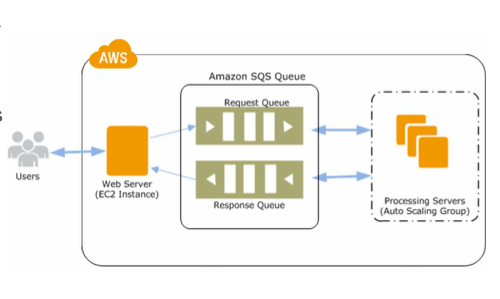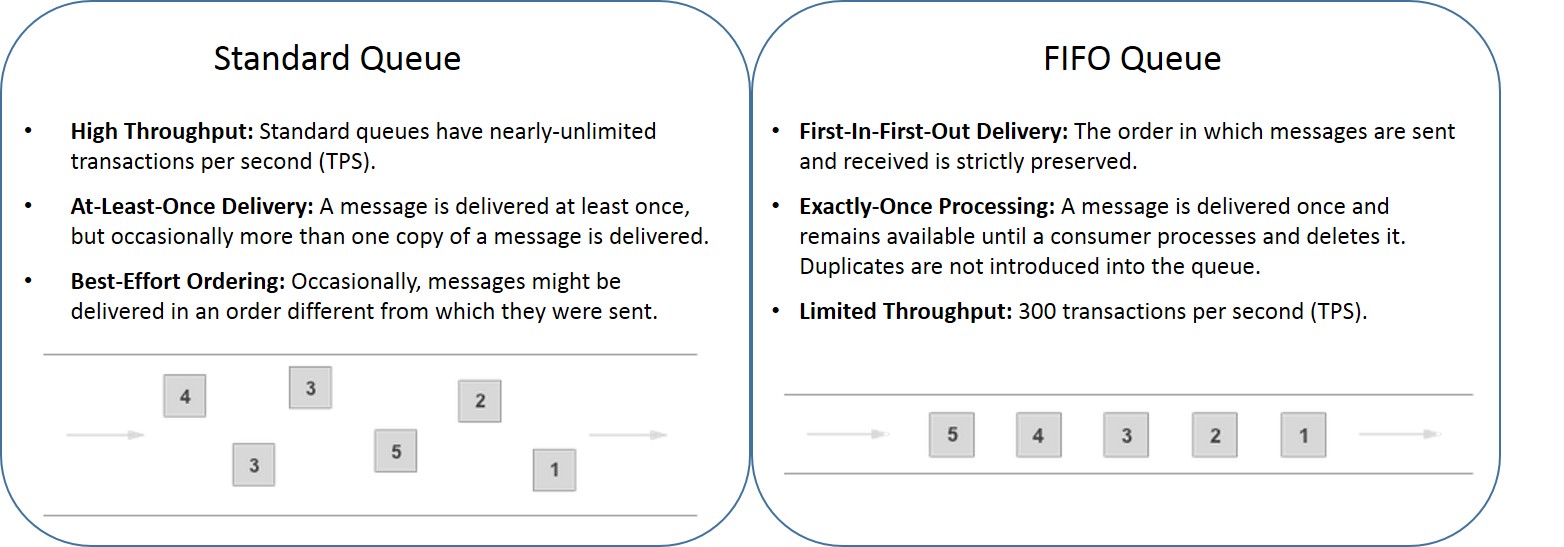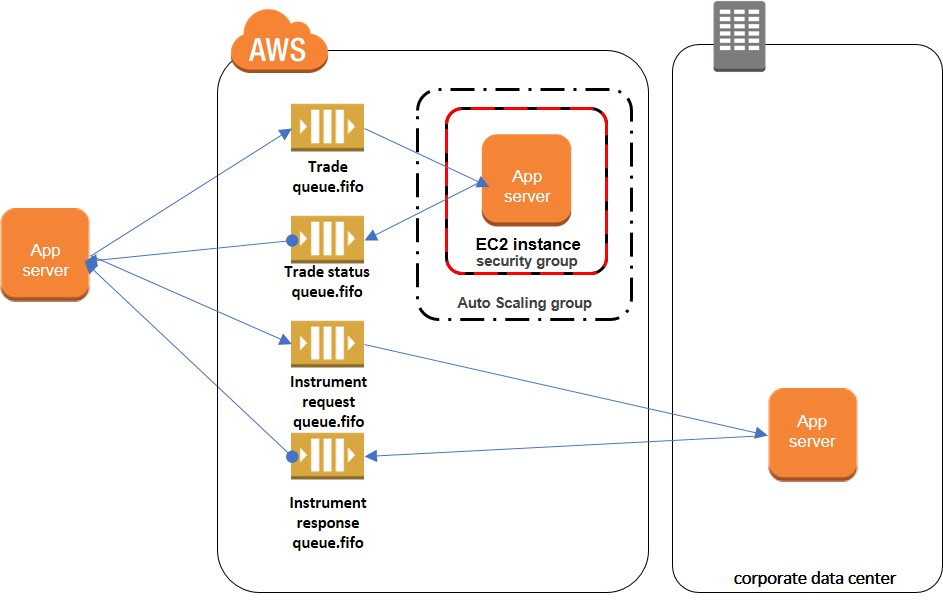AWS Developer Tools Blog
Using Python and Amazon SQS FIFO Queues to Preserve Message Sequencing
Thanks to Alexandre Pinhel, Solutions Architect from our team for writing this post!
Amazon SQS is a managed message queuing service that makes it simple to decouple application components. We recently announced an entirely new queue type, SQS FIFO (first-in, first out) queues with exactly-once processing and deduplication. SQS FIFO queues are now available in the US East (Ohio) and US West (Oregon) regions, with more regions to follow. This new type of queue lets you use Amazon SQS for systems that depend on receiving messages in exact order, and exactly once, such as financial services and e-commerce applications. For example, FIFO queues help ensure mobile banking transactions are processed in the correct sequence, and that inventory updates for online retail sites are processed in the right order. In this post, we show how to use FIFO queues to preserve message sequencing with Python.
FIFO queues complement our existing SQS standard queues, which offer higher throughput, best-effort ordering, and at-least-once delivery. The following diagram compares the features of standard queues vs. FIFO queues. The same API functions apply to both types of queues.
The below use case provides an example of how you can now use SQS FIFO queues to exchange sequence-sensitive information. For more information about developing applications using Amazon SQS, see the Amazon SQS Developer Guide.
SQS FIFO Queues Example
In the capital markets industry, some of the most common patterns for exchanging messages with partners and customers are based on messaging technologies with two types of scenarios:
- Communication channels between two messaging managers (one sender channel and one receiver channel). Each messaging manager hosts the local queue and has an alias to the remote queue hosted on the other side (an MQ manager). The messages sent from an MQ manager are not stored locally. The receiving MQ manager stores the messages for the client applications of the named queues.
- A single messaging manager that hosts all the queues and that has the associated responsibility for message exchange and backup.
You can use Amazon SQS to decouple the components of an application so that these components can run independently, as expected in a messaging use case. The following diagram shows a sample architecture using an SQS queue with processing servers.

To preserve the order of messages, we use FIFO queues. These queues help ensure that trades are received in the correct order, and a book event is received before an update event or a cancel event.
Important: The name of a FIFO queue must end with the .fifo suffix.
The following diagram shows a financial use case, where Amazon SQS FIFO queues are used with different processing servers based on the type of messages being managed.
In FIFO queues, Amazon SQS also provides content-based deduplication. Content-based deduplication allows SQS to distinguish the contents of one message from the contents of another message using the message body. This helps eliminate duplicates in referential systems such as those that manage pricing.
In the following example, we simulate the two parts of a capital market exchange. In the first part, we simulate the application sending the trade status and sending messages to the queue named Trade Status. (In Amazon SQS, the queue will be named TradeStatus.fifo.) The application regularly sends trade status received during the trade lifecycle in the queue (for example, trade received, trade checked, trade confirmed, and so on). In the second part, we simulate a client application that gets the trade status to update an internal website or to send status update notifications to other tools. The script stops after the message is read.
To accomplish this, you can use the following two Python code examples. This example is using boto3, the AWS SDK for Python.
This first script sends an XML message to a queue named TradeStatus.fifo, and the second script receives the message from the same queue. Messages can contain up to 256 KB of text in any format. Any component can later retrieve the messages programmatically using the Amazon SQS API. You can manage messages larger than 256 KB by using the SQS Extended Client Library for Java, which uses Amazon S3 to store larger payloads.
For queue creation, please see the Amazon SQS Developer guide.
Name: TradeStatus.fifo
URL: https://sqs.us-west-2.amazonaws.com/12345678/TradeStatus.fifo
The scripts below are in Python2.
import boto3
# Get the service resource
sqs = boto3.resource('sqs')
# Get the queue
queue = sqs.get_queue_by_name(QueueName='TradeStatus.fifo')
try:
userInput = raw_input("Please enter file name: ")
except NameError:
pass
with open(userInput, 'r') as myfile:
data=myfile.read()
response = queue.send_message(
MessageBody=data,
MessageGroupId='messageGroup1'
)
# The response is NOT a resource, but gives you a message ID and MD5
print(response.get('MessageId'))
print(response.get('MD5OfMessageBody'))
The following Python code receives the message from the TradeStatus.fifo queue and deletes the message when it’s received. Afterward, the message is no longer available.
import boto3
# Get the service resource
sqs = boto3.resource('sqs')
# Get the queue
queue = sqs.get_queue_by_name(QueueName='TradeStatus.fifo')
# Process messages by printing out body
for message in queue.receive_messages():
# Print out the body of the message
print('Hello, {0}'.format(message.body))
# Let the queue know that the message is processed
message.delete()
Note: In Python, you need only the name of the queue.
More Resources
In this post, we showed how you can use Amazon SQS FIFO queues to exchange data between distributed systems that depend on receiving messages in exact order, and exactly once. You can get started with SQS FIFO queues using just three simple commands. For more information, see the following resources:
- SQS website
- SQS Documentation: FIFO Queues
- AWS Blog: FIFO Queues with Exactly-Once Processing & Deduplication
- Amazon Simple Queue Service API Reference, which provides complete descriptions of the API actions, parameters, and data types, as well as a list of errors that the service returns.

